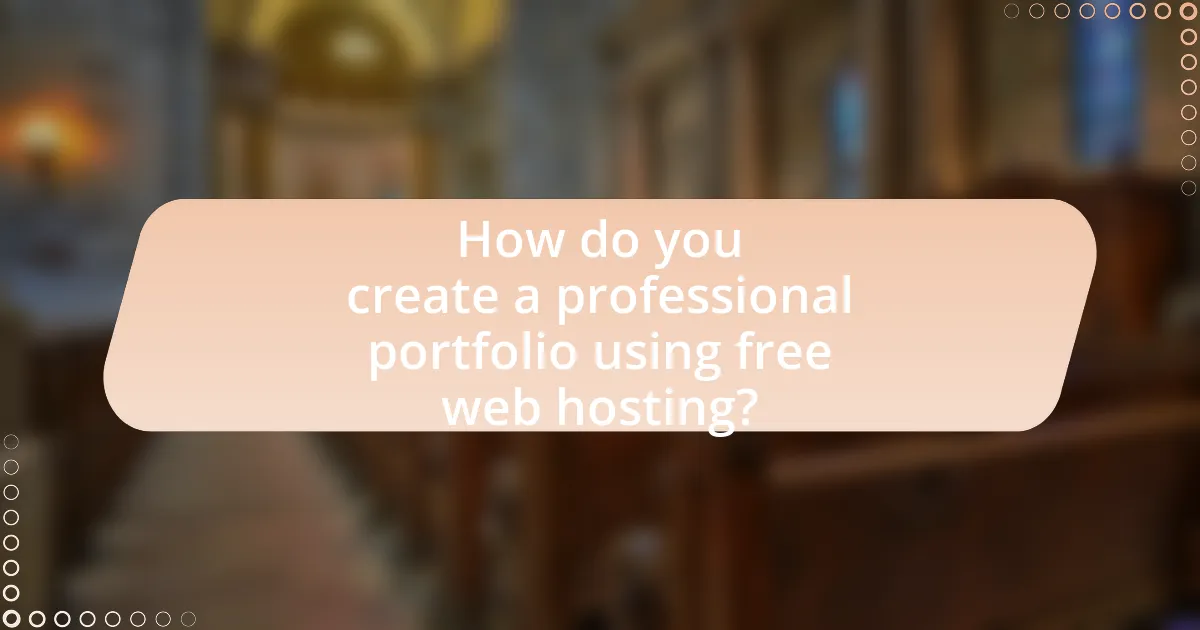Creating a professional portfolio with free web hosting enables individuals, particularly freelancers and job seekers, to showcase their skills and work samples online without incurring costs. This article outlines the benefits of using free web hosting platforms, such as WordPress and Wix, to enhance career prospects by presenting a visually appealing collection of work. Key elements of an effective portfolio, strategies for optimization, and best practices for maintenance are discussed, along with the importance of user experience and storytelling in portfolio design. Additionally, the article addresses the limitations of free hosting services compared to paid options, ensuring readers understand how to maximize their online presence while navigating potential challenges.

What is Creating a Professional Portfolio with Free Web Hosting?
Creating a professional portfolio with free web hosting involves designing and publishing a collection of work samples online without incurring hosting costs. This process allows individuals, particularly freelancers and job seekers, to showcase their skills, projects, and achievements to potential employers or clients. Free web hosting services, such as WordPress.com or Wix, provide user-friendly platforms that enable users to create visually appealing portfolios without requiring extensive technical knowledge. The effectiveness of a professional portfolio is supported by research indicating that 56% of employers prefer candidates with an online portfolio, highlighting its importance in the job market.
How can a professional portfolio enhance your career prospects?
A professional portfolio enhances career prospects by showcasing an individual’s skills, experiences, and accomplishments in a visually appealing format. This tangible representation of work allows potential employers to assess a candidate’s qualifications and creativity effectively. Research indicates that 56% of hiring managers prefer candidates with portfolios, as they provide concrete evidence of abilities rather than relying solely on resumes. Furthermore, a well-organized portfolio can differentiate a candidate in competitive job markets, increasing the likelihood of securing interviews and job offers.
What elements should be included in a professional portfolio?
A professional portfolio should include a clear introduction, a resume, work samples, case studies, testimonials, and a contact section. The introduction provides an overview of the individual’s professional background and objectives. The resume outlines relevant experience and skills, while work samples showcase the individual’s best projects, demonstrating their capabilities. Case studies offer in-depth analysis of specific projects, highlighting problem-solving skills and outcomes. Testimonials from clients or colleagues add credibility, and the contact section ensures potential employers or clients can reach the individual easily. These elements collectively present a comprehensive view of the professional’s qualifications and achievements.
Why is it important to showcase your work effectively?
Showcasing your work effectively is crucial because it directly influences how potential clients or employers perceive your skills and capabilities. An effective showcase highlights your strengths, demonstrates your expertise, and differentiates you from competitors. Research indicates that visual presentation can increase engagement; for instance, a study by the Nielsen Norman Group found that users form opinions about a website within 50 milliseconds, emphasizing the importance of first impressions. Therefore, an organized and visually appealing portfolio can significantly enhance your chances of attracting opportunities in a competitive job market.
What are the advantages of using free web hosting for your portfolio?
Using free web hosting for your portfolio offers several advantages, primarily cost-effectiveness and accessibility. Free web hosting allows individuals to showcase their work without incurring expenses, making it an ideal option for students or those starting their careers. Additionally, many free hosting services provide user-friendly interfaces and templates, enabling users to create professional-looking portfolios quickly. According to a survey by HostingAdvice, 70% of users reported that ease of use was a critical factor in their choice of web hosting, highlighting the importance of accessibility in portfolio creation.
How does free web hosting compare to paid options?
Free web hosting typically offers limited features and resources compared to paid options. Paid hosting services generally provide enhanced performance, greater storage capacity, and better security measures, which are crucial for a professional portfolio. For instance, paid plans often include custom domain names, SSL certificates, and customer support, while free hosting may impose bandwidth restrictions and display ads on your site. According to a 2021 survey by HostingAdvice, 70% of users reported that paid hosting significantly improved their website’s speed and reliability, underscoring the advantages of investing in a paid service for a professional online presence.
What limitations should you be aware of with free web hosting?
Free web hosting typically comes with several limitations that can hinder the effectiveness of a professional portfolio. These limitations include restricted storage space, which often caps at a few hundred megabytes, making it difficult to host high-quality images or extensive content. Additionally, free hosting services frequently impose bandwidth limits, resulting in slow loading times or downtime during peak traffic periods.
Moreover, users may face a lack of customer support, leaving them without assistance during technical issues. Free web hosting often includes mandatory advertisements, which can detract from the professional appearance of a portfolio. Furthermore, users may not have access to custom domain names, limiting branding opportunities. Security features are often minimal, increasing vulnerability to cyber threats. These factors collectively make free web hosting less suitable for creating a professional portfolio.

How do you create a professional portfolio using free web hosting?
To create a professional portfolio using free web hosting, first select a reliable free web hosting service such as WordPress.com, Wix, or GitHub Pages. These platforms provide user-friendly interfaces and templates that facilitate the design and organization of your portfolio. Next, gather your work samples, including projects, images, and descriptions, to showcase your skills effectively. After that, customize your chosen template to reflect your personal brand, ensuring that it is visually appealing and easy to navigate. Finally, publish your portfolio and share the link on professional networks like LinkedIn to increase visibility. This approach is validated by the widespread use of these platforms by professionals to establish an online presence without incurring costs.
What steps are involved in setting up your portfolio?
To set up your portfolio, follow these steps: First, choose a platform that offers free web hosting, such as WordPress, Wix, or GitHub Pages. Next, select a template that aligns with your professional style and the type of work you want to showcase. After that, gather your best work samples, including images, documents, or links, and organize them into categories for easy navigation. Then, write an engaging bio that highlights your skills and experiences, ensuring it reflects your professional identity. Finally, publish your portfolio and share it across your professional networks to attract potential clients or employers. These steps are essential for creating an effective online presence that showcases your work and skills.
How do you choose the right free web hosting service?
To choose the right free web hosting service, evaluate the features, reliability, and limitations of each option. Key factors include storage space, bandwidth, uptime guarantees, and customer support. For instance, services like InfinityFree offer unlimited storage and bandwidth, while others may impose strict limits. Additionally, consider the ease of use and whether the platform supports essential features like website builders or content management systems. Research user reviews and ratings to assess reliability; for example, a service with a 99.9% uptime guarantee is generally more dependable.
What tools can help you design your portfolio effectively?
To design your portfolio effectively, tools such as Adobe XD, Canva, and WordPress are highly recommended. Adobe XD offers a robust platform for creating interactive designs and prototypes, making it suitable for visually appealing portfolios. Canva provides user-friendly templates and design elements that simplify the process for those without extensive design skills. WordPress, a widely-used content management system, allows for customizable portfolio layouts and easy integration of multimedia content. These tools are validated by their popularity among designers and their ability to enhance the visual presentation and functionality of online portfolios.
How can you optimize your portfolio for visibility?
To optimize your portfolio for visibility, ensure it is hosted on a reliable platform that supports SEO best practices. Utilizing free web hosting services like WordPress or Wix can enhance visibility through built-in SEO tools, customizable URLs, and mobile responsiveness. Additionally, incorporating relevant keywords in your content and meta tags can improve search engine rankings. According to a study by HubSpot, 75% of users never scroll past the first page of search results, highlighting the importance of SEO in driving traffic to your portfolio.
What SEO strategies should you implement for your portfolio?
To optimize your portfolio for search engines, implement strategies such as keyword optimization, quality content creation, and backlink building. Keyword optimization involves researching and incorporating relevant keywords that potential clients might use to find services similar to yours, ensuring these keywords appear in titles, headings, and throughout the content. Quality content creation focuses on producing engaging, informative, and original content that showcases your skills and projects, which can improve user engagement and dwell time, factors that search engines consider for ranking. Backlink building entails acquiring links from reputable websites to your portfolio, enhancing its authority and visibility in search results. According to a study by Moz, backlinks are one of the top three ranking factors for Google, highlighting their importance in SEO strategy.
How can social media enhance the reach of your portfolio?
Social media can enhance the reach of your portfolio by providing a platform for sharing your work with a broader audience. By leveraging social media channels, individuals can showcase their portfolios to potential clients, employers, and collaborators, significantly increasing visibility. For instance, a study by the Pew Research Center indicates that 69% of adults in the U.S. use social media, which highlights the vast audience available for portfolio promotion. Additionally, engaging content shared on platforms like Instagram, LinkedIn, and Twitter can lead to increased traffic to your portfolio site, as posts can be easily shared and liked, creating a ripple effect that attracts more viewers.

What are the best practices for maintaining a professional portfolio?
The best practices for maintaining a professional portfolio include regularly updating content, ensuring a user-friendly design, and showcasing relevant work. Regular updates keep the portfolio current and reflect ongoing professional development, which is essential as industries evolve. A user-friendly design enhances accessibility and engagement, making it easier for potential employers or clients to navigate. Showcasing relevant work demonstrates skills and expertise aligned with career goals, increasing the likelihood of attracting opportunities. According to a survey by the Creative Group, 70% of hiring managers prefer portfolios that are easy to navigate and visually appealing, underscoring the importance of these practices.
How often should you update your portfolio?
You should update your portfolio at least every six months. Regular updates ensure that your portfolio reflects your most current skills, experiences, and projects, which is crucial in a rapidly changing job market. According to a survey by the National Association of Colleges and Employers, 70% of employers prefer candidates whose portfolios showcase recent work, indicating that timely updates can significantly enhance your employability.
What types of content should be prioritized in updates?
Visual content, such as high-quality images and videos, should be prioritized in updates for a professional portfolio. This type of content effectively showcases skills and projects, making them more engaging for viewers. Research indicates that visual content can increase user engagement by up to 94%, highlighting its importance in capturing attention and conveying information efficiently. Additionally, incorporating written content that includes project descriptions, case studies, and testimonials can further enhance the portfolio’s credibility and provide context to the visual elements.
How can feedback improve your portfolio over time?
Feedback can significantly enhance your portfolio over time by providing insights into strengths and weaknesses. Constructive criticism allows you to identify areas for improvement, ensuring that your work aligns with industry standards and audience expectations. For instance, feedback from peers or mentors can highlight specific skills that need refinement or showcase successful elements that resonate well with viewers. Regularly incorporating this feedback leads to a more polished and effective portfolio, ultimately increasing its appeal and relevance in a competitive job market.
What common mistakes should you avoid when creating your portfolio?
Common mistakes to avoid when creating your portfolio include using low-quality images, neglecting mobile optimization, and failing to showcase your best work. Low-quality images can detract from the professionalism of your portfolio, as studies show that visual appeal significantly influences first impressions. Neglecting mobile optimization is critical because over half of web traffic comes from mobile devices, and a non-responsive design can lead to a poor user experience. Additionally, failing to showcase your best work can result in missed opportunities; research indicates that presenting a curated selection of high-quality projects is more effective than displaying everything you have done.
How can poor design choices affect your portfolio’s effectiveness?
Poor design choices can significantly diminish a portfolio’s effectiveness by hindering user engagement and accessibility. For instance, cluttered layouts or inconsistent color schemes can distract viewers, leading to a negative user experience. Research indicates that 94% of first impressions are design-related, highlighting the importance of visual appeal in retaining audience attention. Additionally, poor navigation can frustrate users, causing them to leave the site prematurely; studies show that 38% of users will stop engaging with a website if the content or layout is unattractive. Therefore, effective design is crucial for maximizing a portfolio’s impact and ensuring that it communicates the intended message clearly.
What are the risks of using too many free resources?
Using too many free resources can lead to several risks, including lack of reliability, limited functionality, and potential security vulnerabilities. Free resources often come with restrictions that can hinder the performance and scalability of a professional portfolio. For instance, many free web hosting services impose bandwidth limits, which can result in slow loading times or downtime during high traffic periods. Additionally, free resources may not offer robust security measures, making portfolios susceptible to hacking or data breaches. According to a study by the Ponemon Institute, 60% of small businesses that experience a data breach close within six months, highlighting the critical importance of security in online platforms. Therefore, relying excessively on free resources can compromise the quality and safety of a professional portfolio.
What tips can help you create an impactful portfolio?
To create an impactful portfolio, focus on showcasing your best work, ensuring clarity and organization. Highlighting your most relevant projects demonstrates your skills effectively, while a clean layout enhances user experience. Research indicates that visually appealing portfolios can increase engagement by up to 80%, emphasizing the importance of design. Additionally, including concise descriptions of each project provides context and showcases your thought process, which can further impress potential employers or clients.
How can storytelling enhance your portfolio presentation?
Storytelling can enhance your portfolio presentation by creating an emotional connection with the audience, making your work more memorable and engaging. When you weave narratives around your projects, you provide context that highlights your thought process, challenges faced, and solutions implemented, which can demonstrate your skills and creativity effectively. Research indicates that stories are 22 times more memorable than facts alone, as shown in a study by the University of California, which underscores the power of narrative in retaining information. This approach not only showcases your work but also illustrates your personal journey and professional growth, making your portfolio stand out in a competitive landscape.
What role does user experience play in portfolio design?
User experience is crucial in portfolio design as it directly influences how effectively a viewer interacts with and perceives the portfolio. A well-designed user experience ensures that navigation is intuitive, content is easily accessible, and the overall aesthetic aligns with the creator’s brand, which can significantly enhance engagement and retention. Research indicates that 88% of online consumers are less likely to return to a site after a bad experience, highlighting the importance of user-centric design in retaining potential clients or employers.